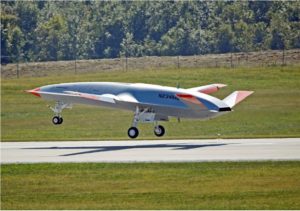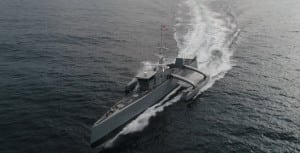A Navy official on Tuesday explained the service’s unmanned campaign plan to build a centralized management and leadership of technologies supporting all unmanned platforms.
The plan, directed by the Chief of Naval Operations Adm. Michael Gilday, essentially is about bringing together unmanned Navy aviation, surface, and undersea programs, “looking at them critically and understanding where we were as a Navy,” Vice Adm. James Kilby, Deputy Chief of Naval Operations for Warfighting Requirements and Capabilities, N9 said during the virtual AUVSI Unmanned Systems conference Tuesday.

“So when we started to do our work for CNO Gilday, we found that the platforms are all maturing, they generally have a plan, there are certainly some things we have to address within each of the domains.”
However. Kilby said he was surprised that all the enabling technologies the Navy was going to rely on to bring these to bear for distributed maritime operations “really need a critical eye,” he continued.
Therefore Kilby said he is working with Deputy Chief of Naval Operations for Information Warfare, N2/N6, Vice Adm. Jeffrey Trussler, on the campaign plan in an effort to have a centralized management and leadership of the enabling technologies for the unmanned platforms across resource sponsors.
Kilby named the enabling technologies as the naval tactical grid, artificial intelligence and machine learning, and the Common Control System.
He said the tactical grid is “the ability to network and control C2, all those unmanned vehicles is significant and important. Think about the aggregation of that demand on the network and understanding that and making sure we field a network that’s robust enough to handle all our vehicles in many different types of environments.”
He underscored that is of “primary importance” to them and is their focus.
“It’s not just an N2/N6 thing and it’s not just an N9 thing – it’s the platform sensors, weapons together with the resource sponsor for the networks that will bring this together. So we’re committed to that work and advancing that front.”
Kilby also said artificial intelligence and machine learning is important in this process.
“How can we use these technologies to help support not only our manned platforms but our unmanned platforms? So we’ve made some headway here in the last few years with some programs that are looking very successful to us, but to understand how to do that throughout all our vehicles in the future is of primary importance to us.”
He said this is all dependent on construction, curation, and storage of data.
“So these things are all intertwined and don’t have a single owner, but really are owned and impacted by everyone in the Navy.”
Kilby also referenced the Common Control System, which the Navy has developed as a single command and control system across various unmanned platforms.
“So think about a single system that allows us to control multiple vehicles and that’s a requirement for the Navy. So if you have a platform that chooses not to or can’t use the common control station, you have to seek a waiver to do that,” Kilby said.
He argued that is important because “we view the world in the future of distributed maritime operations in a place where an air vehicle might have control of the surface vehicle and have to pass that control to a manned surface vessel or this unmanned operations center of the future. The ability to have a single control station that allows us to do that seamlessly will help us with training and the advancement and update of our systems in the future.”
Kilby said when he reported to Gilday he focused on those enabling technologies “and I said, CNO, that’s a place we need to work in the future.”
Separately, speaking at the AUVSI event, Assistant Secretary of the Navy for Research, Development and Acquisition James Geurts said part of the campaign plan will help on aligning requirements.

Geurts said it will be a challenge for the Navy to keep ahold of the various unmanned systems and data management and knowledge management and “not reinventing the wheel over and over and over I think will be one of the barriers to us scaling.”
He noted the service is trying to move from a collection of unmanned systems into a more integrated capability in the campaign plan requiring more unified command and control, concept of operations, and data systems.
“That’s another idea, quite frankly this campaign plan, you know on the requiring side. Another reason we’re doing this is so we can align requirements and not have those differing requirements groups operating separately,” he added.
Previously, in July, Geurts emphasized the MQ-25 would be part of this campaign plan and described it in broad strokes (Defense Daily, July 30).
“We’ve got a really large campaign going on right now of how do we really integrate all of these unmanned assets – under the water, on the water, above the water, holistically across the fleet.”
He said the campaign plan has the facets of training on command and control, maintenance, control and data sharing.
“I think we’re cranking on, on the plan we have, and taking advantage of opportunities where we see it, and mitigating risk where those come up,” he said in July.